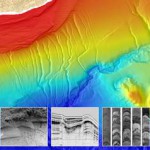It’s not easy to prepare weekly Friday links when you are abroad, this is what I had to realize in April. However, I will try to post a natural beauty each Wednesday in the future, the Wednesday Centerfaults and Centerfolds.
Today, I start with the Kaparelli Fault in Greece (38.22°N, 23.23°E). This beautiful limestone fault scarp is more than 2.5 km long and up to 5 m high. The fault was activated during the 1981 Corinth earthquakes. more
Some days ago, a great new paper was published on the investigation of soft-sediment deformation in paleoseismology: “Alsop & Marco 2011: Soft-Sediment deformation within seismogenic slumps of the Dead Sea Basin. Journal of Structural Geology 33 (2011) 433-457.” The authors investigated the most beautiful seismites I’ve ever seen and generated different scenarios for their interpretation with respect to paleoseismic events. more
Now the EGU2011 in Vienna is over. Thousands of scientists have attended the meeting and more than 13,000 abstratcs were presented. Approx. 20,000 portions of Gulasz and 100,000 Wiener Schnitzels were served, hektoliters of wine and beer went down the throats of thirsty scientists. Some people say the EGU contributes with 10% to the income of Vienna’s bartenders. Several contributions dealt with paleoseismology, paleoseismicity, archeoseismology and paleotsunamis especially on Monday and Friday. more
The Japan earthquake and tsunami have hit Japan harder than we could have imagined. Thousands are still missing, the death toll climbs and climbs, a nuclear disaster might happen or already happened, depending on who you ask, and the economical damages are incredibly high. Not only Japan was affected, but other countries as well feel the effects. Germany, for example, shut down seven of it’s oldest nuclear power plants and there’s a big debate on earthquakes and risks. The Geoblogosphere is still discussing lessons, estimations and consequences, and so are the official media. Here are some reports and opinions you should not miss. more
The Japan M9.0 earthquake and the following tsunami are well documented by videos, photographs, sea-level measurements, seismograms etc. But how do we recognize such huge events if they happened some thousands of years ago? If there’s no historical report we would use earthquake environmental effects (EEE) for characterizing the earthquake and paleoseismicity. Let’s look what would be left from a 5000 year old earthquake and tsunami. more
An earthquake with a magnitude of Mw9.0 has occured 130 km east of Honshu, Japan in a depth of ~25 km. This had been the fourth or fifth strongest earthquake to be recorded by instrumental seismology. The quake caused significant destruction to the Honshu Island and triggered a tsunami that destroyed a number of harbours. In some places (Sendai), tsunami heights were reported to exceed 10 m. A tsunami warning has been released for wide parts of the Pacific, but in Hawaii only 1 m was observed, therefore the warnings for the US West Coast have been lowered. more
The Christchurch earthquake was the main topic of the Geoblogosphere this week. A great analysis on the effects was provided by Dave Petley in his Landslide Blog. Highly Allochthonous reasoned on seismic lensing, Ontario Geofish posted a lot on building security, and countless news sites came up with photos and reports. Frank Taylor, who hosted the GoogleEarthBlog before he left for a sailing trip around the world, was in Christchurch next to the Cathedral when the quake happened. On his Tahina Expedition website he reports on his experiences.
more
A M6.3 earthquake hit Christchurch, New Zealand on 22 February (21 Feb in UTC), leaving at least 75 people dead and hundreds injured or missing. Hundreds of houses were destroyed, including the Christchurch Cathedral, and damages will probably sum up to some billion dollars. On 4 September 2010 (3 Sept in UTC), a M7.0 event struck Christchurch, but then no one was killed. So: what’s the difference between the two events?
more
 In its latest issue, EOS reports on the European Science Foundation conference “Submarine Paleoseismology – The Offshore Search of Large Holocene Earthquakes” which was held in Obergurgl, Austria from 11-16 September 2010.
In its latest issue, EOS reports on the European Science Foundation conference “Submarine Paleoseismology – The Offshore Search of Large Holocene Earthquakes” which was held in Obergurgl, Austria from 11-16 September 2010.
more
 The California Geological Survey provides a great online-tool for geoscientist: A fault map of California (Alquist-Priolo-Fault-Zone with all datasets available in PDF and GIS format for free! Start here.
The California Geological Survey provides a great online-tool for geoscientist: A fault map of California (Alquist-Priolo-Fault-Zone with all datasets available in PDF and GIS format for free! Start here.
A volunteer panel that assesses earthquake risks in Utah said it examined nearly 130 school buildings in the state and found more than half fail to meet federal earthquake safety guidelines. Bad news from here.
more


